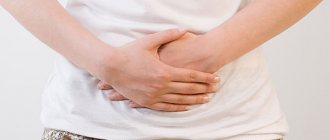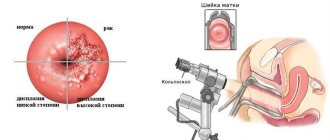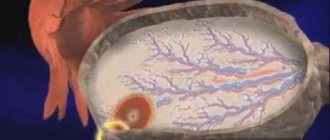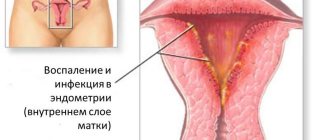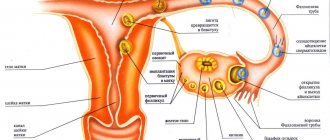Regular painless periods are one of the indicators of women's health. Therefore, any pain that occurs during this period, including if the right side hurts during menstruation, can be considered a reason to visit a gynecologist. The peculiarity and danger of such pain lies in the fact that only a qualified doctor will be able to determine the cause of their occurrence and distinguish between pain associated with neurological pathology or related to surgical diseases. And also to distinguish from pain caused by disorders or inflammation in the reproductive system.
All pain that occurs during menstruation is divided into:
- organic, directly related to disruption of the structure of internal organs and associated with their damage;
- functional, which are caused by the development of a pathological process in organs and their tissues, due to injury or an inflammatory process.
The functional reasons for pain on the right side during menstruation include poor circulation, causing accumulation and stagnation of blood in the uterine cavity. This may be due to the bending of the uterus or the complete absence of defloration. Pain occurs due to hormonal imbalance and primary dysmenorrhea developing against it. Another reason for pain in the side during menstruation is menstrual irregularities and malfunction of the ovaries.
Organic pain can be caused by developing serious diseases, including:
- neoplasms such as fibroids or polyps, adenomyosis or endometriosis;
- inflammation of the right ovary;
- tubal (ectopic) pregnancy;
- oophoritis;
- adnexitis;
- right ovarian cyst;
- polycystic disease
In order to eliminate the need for surgical intervention to provide timely assistance to the patient, it is important to confirm the absence of factors influencing the appearance of severe pain in the right side during menstruation, such as appendicitis or an inflammatory process affecting the liver. A gynecologist can determine the presence of an intrauterine contraceptive device (IUD) in the uterine cavity as the cause of severe pain during menstruation or make a diagnosis of secondary algomenorrhea.
Gynecological diseases as causes of pain attacks
Menstruation - regular bleeding, part of the menstrual cycle - for many women is accompanied by discomfort in the lower abdomen. This may be a normal manifestation of physiological processes or a symptom of a disease. Among the most likely gynecological causes of sudden, sharp pain on the sides of the body below the waist: endometriosis, ovarian cyst, or ectopic pregnancy.
Endometriosis
Pathological growth of the layer of cells in the wall of the uterus occurs. During menstruation, pain caused by inflammation is felt. The process affects the organs that are located in the pelvic cavity. The pain that occurs with endometriosis affects the left or right ovary. In most cases, drug therapy or surgery is required.
Ovarian cyst
Bubbles with liquid or viscous contents appear in the ovary under the influence of hormonal changes during puberty and taking hormonal contraceptives. Most of these formations are benign in nature, but sometimes they occur in connection with ovarian cancer. A small cyst is usually not accompanied by unpleasant sensations, while a large one puts pressure on surrounding organs. There is a delay in menstruation, pain is felt below the waist on the right or left.
Ectopic pregnancy
Sometimes the fertilized egg develops in front of the uterus, in a fallopian tube that is not intended for the fetus. The gradually growing embryo puts pressure on surrounding organs, which causes severe pain. Women are interested in how to get rid of an ectopic pregnancy without surgery. In the early stages, the gynecologist may prescribe the drug Methotrexate, which causes the death of the embryo.
However, pain is not always associated specifically with gynecological problems; it happens that at this time diseases of the gastrointestinal tract, gall bladder or kidneys become aggravated or make themselves felt.
What abnormalities in the ovaries can be diagnosed?
Pain on the left during menstruation occurs with diseases associated with the ovaries:
- tear or torsion on the left side;
- cyst.
An ovarian cyst is accompanied by very strong and sharp pain
Rupture or torsion of the left ovary
In this case, the help of a doctor is urgently required. If the pathology is not treated in time, the organ tissues become necrosis (necrosis) due to increased inflammation.
There are rare cases when the disease appears at rest; most often it occurs with constant strong physical activity. The main symptoms include acute and sharp pain. Discomfort may radiate to the groin or thighs. In addition to discomfort, the patient has a high temperature and increased sweating. Pathology is determined by the appearance of nausea, vomiting, and headaches. Blood may come out of the vagina due to necrosis of the walls of blood vessels.
Ovarian cyst
It is a common pathology. The tumor may be in the left or right ovary. Cyst symptoms include:
- acute or nagging pain;
- disturbance in the menstrual cycle;
- changes in the functioning of the gastrointestinal tract;
The cause may also be problems in the digestive system.
- severe pain before menstruation;
- edema;
- temperature rise to high values.
If a woman ruptures a cyst, dangerous complications may arise in the form of peritonitis, infertility and others.
Inflammation of the appendix
Acute or chronic appendicitis occurs at any age, but is more common in people between 10 and 30 years of age. The main causes of inflammation of the appendix of the cecum are solid impurities in food (seeds, husks), and less often - bacterial infection.
- pain in the right side of the abdomen at or below the waist;
- loss of appetite;
- nausea, vomiting;
- elevated body temperature (optional).
Read about other symptoms here.
Important! Appendicitis is dangerous due to perforation of the walls and release of intestinal contents into the abdominal cavity, which leads to peritonitis. There is a risk of infection spreading in the body (sepsis).
- the symptoms of the disease may be the same as with inflammation of the gallbladder;
- pain in the upper abdomen on the right under the ribs, migrates to the navel;
- Uncharacteristic symptoms often occur, such as drowsiness;
- inflammation and pain are mild in older people;
- Pain in pregnant women occurs in the back and upper abdomen.
In most cases of inflammation of the appendix, surgery is performed to avoid dangerous complications. An appendectomy is performed under local anesthesia. If it is unknown why it hurts in the right side, and there is a suspicion of appendicitis, then you should not take analgesics so as not to complicate the diagnosis of the disease. You should definitely seek medical help.
Pain in the right and left side in women
Gradually increasing pain on the right side, accompanied by fever, intoxication, nausea and vomiting, may indicate inflammation of the appendix. The patient requires emergency consultation with a surgeon and surgical intervention.
Pain in the right side occurs with terminal ileitis, when inflammation of the final portion of the ileum occurs. The cause of ileitis cannot always be determined; sometimes the disease develops after a bacterial or viral infection, when the muscular valve between the small and large intestine is insufficient. Ileitis is characterized by diarrhea with mucus and blood, pain in the right side, bloating, intestinal colic and fever.
Another cause of pain on the right is gynecological pathology: right-sided inflammation of the uterine appendages, ectopic pregnancy, ovarian apoplexy, tubal pregnancy. However, these same reasons can cause pain in the other side if the pathological process is located on the left side.
Pain in the right side can be due to renal colic, and it spreads to the area of the bladder and genital organs of a woman, usually accompanied by dysuric phenomena (frequent and painful urination).
Pain on the left side of the abdomen also has various causes. On the left side there are abdominal organs such as the spleen, pancreas, and stomach. Pain on the left appears with pancreatitis, an increase in the size of the spleen, peptic ulcer, diaphragmatic hernia. In rare cases, they are caused by angina. This atypical localization of symptoms of coronary heart disease occurs mainly in women who complain of pain in the abdomen, lower back or leg at the time of a heart attack.
Painful sensations in the abdomen, accompanied by weakness, cold sweat, excessive pallor, nausea and dizziness, occur due to internal bleeding. Sometimes the patient’s life depends on the speed of assistance
Causes of pain before and after menstruation
The appearance of nagging pain before menstruation a few days before its onset is normal for most women. The pain is dull, nagging in nature, and radiates to the lumbar region. With the onset of menstruation, the pain stops and most often additional therapeutic measures are not required.
Abdominal discomfort is provoked by prolonged stressful situations, alcohol intake, and physical fatigue. Sometimes the cause of a woman’s illness is a change in hormonal levels.
Intense abdominal pain before menstruation occurs in the presence of gynecological pathology - a fibromatous node in the uterus, an ovarian cyst, after abdominal surgery, or hormonal imbalance in the body.
If pain occurs in the abdomen during menstruation, and after it ends or persists or intensifies, the following pathology can be suspected:
- Endometriosis is the spread of cells from the inner layer of the uterus to other tissues of the body. It is possible for the endometrium to be thrown into the abdominal cavity during menstruation, but more often it grows into the muscular layer of the uterus. Since endometrial tissue is hormone-dependent, during menstruation the same changes occur in it as in the inner layer of the uterus. This is manifested by monthly bleeding into surrounding tissues and organs, which leads to their inflammation, as well. consequently, to pain symptoms. Endometriosis is the most common cause of abdominal discomfort after menstruation in women.
- Uterine fibroids. The disease can be asymptomatic or manifest itself with heavy bleeding and pain in the lower abdomen. Myoma can cause miscarriage, infertility, and anemia.
- Endometrial polyps;
- Peritoneal adhesions;
- Inflammation of the appendages;
- Presence of an intrauterine device.
If a woman’s condition worsens after menstruation, the temperature rises, or purulent vaginal discharge appears, it is necessary to urgently consult a doctor for a diagnosis.
Pain during ovulation
Often, women in the middle of the menstrual cycle experience weak nagging pain in the lower abdomen, which indicates ovulation. The pain may be accompanied by spotting, which goes away within 1-2 days. The reason for their appearance is a rupture of the follicle, fluid mixed with blood flows out of it. This is accompanied by contractions of the uterus, which causes discomfort in women.
Severe cramping pain during ovulation may indicate a dangerous pathology - ovarian apoplexy. When the follicle ruptures, the ovarian tissue becomes saturated with blood, followed by massive bleeding into the abdominal cavity. The symptoms resemble an “acute abdomen”: pallor appears, a sharp drop in blood pressure, severe pain, and fainting.
Pain in the lower abdomen during pregnancy
Some women experience physiological pain in the first trimester. The following factors can be cited as their cause: enlargement of the uterus, stretching of muscles and ligaments, a shift in the body’s center of gravity, and changes in a woman’s hormonal levels. Such symptoms are completely harmless, but still the expectant mother should see a gynecologist for preventive purposes.
In another situation, severe abdominal pain can pose a threat to the course of pregnancy and the life of the unborn baby. The most common reasons for their appearance:
- Threat of miscarriage. In this situation, the pain is accompanied by vaginal discharge, which can be either scanty or quite abundant. A woman in such a situation should not panic, since modern medicine has methods for preserving pregnancy when there is a threat of miscarriage. You need to calm down, lie down in bed and call an ambulance as quickly as possible.
- Ectopic pregnancy, when the fertilized egg does not enter the uterine cavity, but stops in the area of the fallopian tube. Gradually increasing in size, the embryo destroys its wall and provokes a pipe rupture. In this case, the woman complains of acute pain in the abdomen, which spreads to the lower back and rectum. Bleeding occurs; As a rule, it is not possible to save the pipe. Treatment is carried out surgically.
- A frozen pregnancy occurs when there is intrauterine death of the fetus. The uterus begins to contract to push the fetus out. Pain in the lower abdomen and spotting appear.
Any ailment during pregnancy should not be ignored. If the pain is not severe, you can recommend contacting an antenatal clinic. If bleeding, acute pain in the abdomen, a drop in blood pressure, or fainting occurs, urgent hospitalization is necessary.
Pain after intercourse
Their cause may be the hasty actions of a man, the lack of necessary foreplay, when a woman is not prepared for sexual intercourse. The small size of the vagina may not accommodate the penis; sometimes this situation occurs with cicatricial changes in the genital organs, for example, after an epistomy.
In menopausal women, dry mucous membranes of the genital tract appear, then frictions give her unpleasant sensations.
Abdominal pain after sexual intercourse can signal inflammation of the genitourinary organs, adhesions in the pelvis, and sexually transmitted diseases.
Whatever the nature of the pain, it almost always indicates disturbances in the functioning of the body. Therefore, the right solution would be a medical consultation.
Pain during menstruation
are often taken for granted and expected by women. However, severe spasmodic pain and a constant feeling of discomfort during menstruation greatly complicate a woman’s usual lifestyle. Specialists in the field of gynecology are constantly conducting research aimed at finding safe and effective means of preventing and relieving specific female pain. It is important to clearly distinguish between painful cramps associated with menstruation and pain in the lower abdomen, which can be caused by various diseases. Professional comprehensive diagnostics will help to clearly establish the etiology and prescribe competent therapy. How to learn to correctly interpret unpleasant pain sensations and make the right decision?
Where are period pains located?
Typically, women complain of pain and heaviness in the lower abdomen. There may be pain during menstruation on the right or left. They can differ in character: be sharp or aching, strong or barely noticeable, pulling or sharp. You should be wary of the appearance of bloody discharge, which was preceded by a delay of menstruation by 1-2 weeks. In this case, there is a high risk of ectopic pregnancy or spontaneous abortion.
Pain during menstruation on the left
Such pain is characteristic of dysmenorrhea. These should be distinguished from problems caused by diseases of the colon, liver or gallbladder. As a result of these diseases, stool disorders, bloating, and difficulty defecating are observed.
Pain indicating diseases of the female genitourinary system may be associated with the appearance of a cyst in the ovary. Painful sensations can be noted on both the left and right. They are accompanied by nausea, vomiting, and fever. One of the solutions in this case is surgery.
Pain during menstruation on the right
They are cyclical. Unrelated to menstruation, pain in the right side can be caused by inflammation of the appendix, problems with the ureter or fallopian tubes. An urgent visit to a medical facility and an accurate diagnosis will prevent unwanted consequences.
It’s possible to forget about period pain
The modern homeopathic drug "Remens" will help solve many women's problems. It, although not a hormonal drug, activates the hypothalamic-pituitary-ovarian system and stimulates the body’s independent production of hormones. While taking the drug, stabilization and correction of the menstrual cycle is observed, imbalances are eliminated, pain during menstruation is alleviated and the woman’s general well-being improves.
When pressing, it hurts in the right side: under the ribs and in the middle and lower parts of the abdomen. Pain in the ovary can be different: only in one, left or right, or two ovaries can hurt at once. Yes, aching pain on the right side closer to the ovaries can occur before menstruation.
And it’s always right, never left. I also have pain, it’s shooting. And just before menstruation, everything is fine on ultrasound. I had such pains that intensified before my period. On the 17th, could it be due to menstruation? And before menstruation it begins to prick, pinch, even as if it were shooting. The pain was like a contraction, it grabbed both ovaries, radiated to the lower back, and went away.
My right ovary also hurts((but I have chronic adnexitis...they also removed my appendix. Because of this, a slight detachment of the endometrium occurs, which is accompanied by pain and spotting for one or two days. So, ladies, don’t worry! I also have pain in my right ovary before menstruation. Once I was even admitted to emergency surgery, it hurt for a day, and there was a pain in my leg. After 2 hours, my period started and the pain immediately went away.
They gave me a course of antibiotics in the hospital and electrophoresis. Lower right abdominal pain is one of the most common reasons for patient visits to the emergency department. There are many structures in the right lower abdominal region where it can occur. The most common cause of pain on the right side, in the lower abdomen, is appendicitis, or inflammation of the appendix. It occurs in about 10% of people and most often occurs between 10 and 30 years of age, although it can occur at any age.
Ovulation pain occurs approximately 2 weeks before your next period, when the egg is released from the ovary. They are relieved by painkillers and rest, but if the pain comes with fever and nausea, infection, then this should be considered as appendicitis.
Kidney stones into the bladder can pass through any part of the urinary tract. This is a very painful process, although it does not cause permanent damage. If a kidney infection is left untreated, it can cause it to spread widely or cause organ damage.
Diverticulitis
The disease is accompanied by the formation of diverticula in the intestinal wall and inflammation of these bulges. If there are multiple non-inflamed growths, they speak of diverticulosis. If the process is accompanied by inflammation, the disease is called diverticulitis. Pain in 90-95% of patients is felt in the descending branch of the large intestine - above or below the navel, on one side or on both sides. In addition to pain, inflammation of the diverticulum is characterized by other symptoms: high fever, flatulence and constipation.
Whether a patient with diverticulitis can do without surgery should be asked by the attending physician. At home, they practice fasting days and consume more liquid food. When the acute stage has passed, you can switch to eating foods rich in fiber. You can ask your doctor how to relieve the pain. Doctors usually prescribe antibiotics and non-narcotic analgesics. If a rupture of the intestinal wall occurs, surgical removal of the damaged area is performed.
Diseases of the excretory organs
Severe pain below the waist is felt with pathologies of the kidneys, bladder and urinary tract.
Urolithiasis disease
The location of pain depends on the location and size of the stones. If they obstruct the outflow of urine from the right kidney, then severe pain appears in the same side, radiating to the back. The urine becomes cloudy and the body temperature rises.
Paracetamol and other non-steroidal anti-inflammatory drugs are used as pain relievers. What to do next? Treatment depends on the complaints and condition of the individual patient, the size and location of the stones. If a urinary tract infection occurs, doctors prescribe antibiotics.
Cystitis
Pain in the lower abdomen, side, and back occurs with bladder infections. The causes of cystitis are various pathogens: bacteria, fungi, viruses. In the acute form of the disease, discomfort increases when urinating. Medicines bring quick relief: antibiotics and painkillers.
Important! In addition to drug treatment, medicinal plants with antimicrobial, antiseptic and anti-inflammatory properties are used: nettle, bearberry leaf, nasturtium.
Acute pyelonephritis
Bacteria rise from the lower urinary tract, penetrate the bloodstream and infect the kidney parenchyma. Unilateral flank pain can be moderate to severe. High fever in acute pyelonephritis most often occurs in children and the elderly. Broad-spectrum antibiotics are used for treatment.
Physiological pain
If during the procedure a woman feels nagging pain in the abdominal area, which does not in any way impair the quality of her life, then this phenomenon is considered normal.
During menstruation, the endometrial layer, which has grown over the course of a month to fully secure the egg, begins to be rejected and removed along with the unfertilized egg from the body through bleeding from the vagina. During this process, small capillaries and nerve endings in the uterine body are damaged, which provokes pain. Also, in order to quickly remove the egg and the protective layer from the body, the muscles of the uterus begin to contract, which also contributes to the appearance of pain.
If pain appears in the right side, this may indicate the presence of dangerous pathologies, usually of the genitourinary system. You should immediately contact a gynecologist who will help determine the true cause of the pain.
Pulling in the lower abdomen after menstruation: pregnancy or pathology
The female body is a harmonious system influenced by hormones and their combinations. All the changes happening to her are aimed at fulfilling the most important mission - the birth of a new life. At the slightest “breakdown,” the body lets you know with pain or unpleasant sensations. That is why, if the lower abdomen feels tight after menstruation, then you need to pay attention to it.
Changes in the cycle
First, let's remember what happens in the female reproductive system during the menstrual cycle.
The onset of menstruation is the first day of the cycle. Bloody discharge indicates renewal of the inner layer of the uterus - the endometrium, in response to the death of an unfertilized egg.
Due to the absence of pregnancy, the concentration of progesterone and estrogen drops sharply, which causes spasm of endometrial vessels and the release of prostaglandins, which provoke uterine contractions.
All this causes spotting and pain in the lower abdomen during menstruation.
Simultaneously with menstruation, the follicular phase begins, during which all changes are aimed at the maturation of the follicle with a new egg.
At this time, the concentration of follicle-stimulating and luteinizing hormones gradually increases.
By days 12–14 of the cycle, ovulation occurs: the mature follicle will burst and the egg, ready for fertilization, will leave the ovary and move through the fallopian tubes into the organ cavity.
Three days later, under the influence of luteinizing hormone, the maturation of the corpus luteum begins at the site of the ruptured follicle. If a girl becomes pregnant, it is this temporary organ that will synthesize pregnancy hormones until the placenta is formed. If the meeting of the egg and sperm does not occur, the corpus luteum atrophies and the cycle repeats.
Physiological causes of pain in the lower abdomen at the end of menstruation
Most often, pain in the lower abdomen accompanies the first 1–3 days of menstruation itself. However, it happens that as a result of hormonal changes in girls with a low pain threshold, the stomach hurts both at the end of menstruation and for several days after it.
If the pain is not accompanied by a cycle disorder, does not cause much discomfort, is not associated with other pathological discharge, lasts no more than 3 days after the end of menstruation and goes away on its own, there is no reason to worry.
Try to get more rest and do light exercise regularly.
For some representatives of the fair sex, ovulation does not fit into book standards and occurs not on days 12–14, but earlier, from days 6 to 10 of the cycle.
During this natural process, due to the rupture of the follicle, a small amount of blood enters the pelvic cavity, which irritates the peritoneum.
Early ovulation is the reason why the lower abdomen and lower back hurt after menstruation.
If such pain in the left or right side lasts no more than two to three days and is not accompanied by pathological signs (bleeding, weakness, lethargy, dizziness, loss of appetite, low blood pressure), you can rest easy.
Beginning of pregnancy
If you have early ovulation and your lower abdomen ache 10–14 days after your period, you should think about the possibility of pregnancy. It is on these days that the fertilized egg may attach to the wall of the uterus.
A woman may feel, in addition to nagging pain, slight weakness and observe short-term, small-volume bleeding for 1–3 days (implantation bleeding).
Sometimes, with an unstable cycle, during the last scanty menstruation a girl experiences just implantation bleeding, then after that the stomach will also hurt due to pregnancy.
If you feel pain in your lower abdomen immediately after your period, this may be the beginning of pregnancy. You need to use a test (modern technologies make them hypersensitive and capable of detecting the onset of gestation at the earliest stages). You can donate blood to determine the concentration of human chorionic gonadotropin (hCG) in a antenatal clinic.
Read about whether it is possible to be pregnant during menstruation and how to distinguish true menstruation.
Intrauterine device
During menstruation, the cervix opens slightly to ensure the normal course of the process. Against this background, the location of the IUD may change, which provokes pain. It usually does not require medical attention and goes away on its own.
Taking hormonal contraceptives
At the very beginning of taking oral contraceptives, the lower abdomen may ache due to hormonal changes in the body. The pills are started when the previous cycle ends.
Typically, pain in the abdominal area is temporary, not very intense and goes away on its own. However, it should be remembered that COCs can cause miscarriage if pregnancy occurs.
Therefore, the use of these drugs should always be coordinated with a gynecologist.
Source: https://MesyachnyeDni.ru/menstruaciya/tyanet-niz-zhivota-posle-mesyachnyh.html
Causes of pain
To the existing question of many about why the right side hurts during and before menstruation, doctors have a scientific answer. This often happens due to the progression of dangerous inflammatory gynecological diseases in the body. It is in this area of the abdomen that the reproductive organs are located. And the appearance of unpleasant sensations precisely on critical days is explained by the fact that changes in the level of sex hormones reduce pain and provoke minor inflammatory processes, in which the symptoms of the existing disease become more pronounced.
Inflammation of the ovary
The ovaries are a paired organ of the reproductive system, the normal functioning of which is responsible for the possibility of fertilization, the synthesis of hormones and normal life functions.
Pain in the right side before or during menstruation may indicate inflammatory processes in the right ovary.
Oophoritis and adnexitis
If a woman repeatedly notices that during her menstrual period her stomach hurts on the right side, this may indicate the presence of inflammatory diseases such as oophoritis and adnexitis. During the progression of such pathologies, the ovaries (one or two) and appendages are affected. These diseases occur due to viral or bacterial infections entering the body, prolonged exposure to cold or reduced immunity. The following signs may also indicate the presence of oophoritis and adnexitis:
The pain that occurs is cutting or aching in nature and intensifies during regulation.
Cyst and polycystic
During the period of ovulation (7-10 days before menstruation), a woman may experience pain in the right side. This phenomenon often indicates the presence of a cyst or polycystic disease in the ovaries. The formation is formed as a result of incomplete opening of the follicle, which does not allow the unfertilized egg to come out, and the development of an inflammatory process in it with the accumulation of purulent fluid and subsequent compaction. The reasons for this condition may be:
- Excess body weight, anorexia;
- Reduced or increased level of the hormone FSH (provokes normal release of the egg);
- Congenital or acquired pathologies of the reproductive system.
Apoplexy
Apoplexy is a life-threatening phenomenon characterized by ovarian rupture. This pathology is accompanied by severe cutting pain, which can occur before, during and after menstruation in the area of the injured organ. Apoplexy can be provoked by:
- Severe injuries;
- Infection;
- Ectopic pregnancy;
- Varicose veins in the ovaries (dilation);
- Long-term inflammation in the ovary and appendages.
This condition requires immediate intervention from medical specialists. Otherwise, the woman will face death due to blood loss.
Endometriosis
If during regular periods or before menstruation the right side hurts, the volume and duration of menstruation has increased, and there is severe weakness, this may mean that a disease such as endometriosis is progressing in the body. This pathology is caused by an unnatural thickening of the protective layer of the uterus (endometrium) and its growth into nearby organs. If the disease is ignored, dangerous consequences can develop, so it is important to consult a doctor promptly.
Myoma
Myomatous nodes are benign neoplasms localized in the uterine cavity. They occur due to hormonal imbalance, the use of IUDs or inappropriate use of oral contraceptives. An enlarged tumor causes muscle tissue to move apart and is accompanied by pain that can radiate to different sides of the abdomen.
Appendicitis
The appendix is a small appendage that is of little use today. It contains microelements that help digest cellulose.
Survey results
If, as a result of the examination, the gynecologist revealed the presence of an inflammatory disease, then therapeutic measures will be aimed at getting rid of this process. Inflammation of the appendages often affects one side, which is why one side hurts. If there is salpingitis or oophoritis on the right, then pain will bother the patient in the right beech. A manual examination, menstruation, and sexual intercourse will be extremely painful. Adnexitis is also accompanied by severe pain, requiring immediate and adequate treatment.
Therapeutic measures include the use of anti-inflammatory drugs, a complex of vitamins, and if necessary, the doctor will prescribe antibiotics. The treatment is a course, the course is at least 10 days. After the attack is stopped, restorative therapy will be required. It is important to consult a doctor in a timely manner, refusing to self-medicate and take painkillers.
One of the most dangerous diseases is apoplexy. The menstrual cycle is divided into several periods, and during the first, under the influence of estrogen, the follicle matures. At a certain time it ruptures and the egg is released. If such a rupture occurs ahead of schedule, it is accompanied by severe cutting pain. There is no conservative treatment for apoplexy. The patient needs urgent surgical intervention.
No less common is the so-called ectopic or tubal pregnancy. A fertilized egg is not able to penetrate the uterine cavity due to adhesions existing in the fallopian tubes, narrowing their lumen. This becomes the reason that the fertilized egg remains in the lumen of the tube, is implanted, and the embryo begins to develop and, of course, grow, increasing in size.
Despite the presence of a fertilized egg, menstruation may occur regularly for several months, in exact accordance with the menstrual cycle. Menstruation is accompanied by nagging pain in the right side if the fertilized egg is in the right tube.
A woman only feels all the signs of pregnancy until the stretching of the tube becomes extreme and it bursts. A rupture of the fallopian tube is accompanied by severe cutting pain and internal bleeding. Without urgent surgical intervention, the patient may die.
Treatment
It is practically impossible to cope with abdominal pain during menstruation on your own, since such a phenomenon often indicates the progression of dangerous diseases.
The doctor, based on the diagnostic results obtained and the individual characteristics of the body, prescribes the most appropriate treatment method.
If foci of inflammation are found in the body, anti-inflammatory drugs are prescribed. For diseases associated with hormonal imbalance, hormonal drugs are prescribed. If the pain was caused by the intrauterine device, it is removed. If tumors are present, surgery is required. The attending physician will advise you in more detail about each method of treating the present disease.
Diagnostic procedures
Gynecology deals with the diagnosis and treatment of pathologies associated with dysfunction in the female genital area. At the first stage, the gynecologist conducts a survey and examination of the patient, finding out the nature of the pain symptoms, the regularity of their manifestation, the possible connection with various conditions - sexual intercourse, physical or nervous strain, etc.
Then the woman is sent for examination.
- Blood and urine tests that make it possible to differentiate gynecological diseases from pathologies of other internal organs that have similar symptoms.
- Taking a smear from the vagina for bacterial culture to identify the presence of pathological microorganisms in the area, which can also cause inflammation and pain.
- Ultrasound diagnostics, magnetic resonance and computed tomography help to establish the presence, location and size of tumors in the reproductive organs.
The therapy used depends on the nature of the identified pathologies. It can be antibiotic, anti-inflammatory or hormonal in nature. If cysts and other neoplasms are detected, the doctor may recommend emergency surgery. Under no circumstances should you refuse the operation - further development of the situation poses a real threat to life.
Source of the article: https://nogostop.ru/spina/pochemu-posle-mesyachnyx-tyanet-poyasnicu.html
Prevention
To prevent the development of dangerous diseases and the appearance of unpleasant symptoms, experts recommend adhering to the following rules:
- Visit a gynecologist at least 2 times a year;
- Play sports;
- Give preference to healthy foods;
- Give up bad habits;
- Use condoms;
- Avoid promiscuity;
- At the first unpleasant signs, go to the hospital.
A feeling of pain in the right side of the lower abdomen in a woman may indicate the development of a large number of disorders: gynecological, from the organs of the urinary and digestive system, and indicate a violation of vascular activity. To make an accurate diagnosis, a comprehensive examination and an in-person examination by a doctor are required. It is necessary to take into account that the feeling of pain in the lower abdomen can radiate to nearby organs: the uterus, clitoris, suprapubic and inguinal area, urethra, buttocks, back, intestines. It may take doctors a long time to identify the exact source of the pain impulse. Chronic pain tends to worsen under the influence of a provoking factor and then subside over a long period of time.
Doctors identify the following main reasons that can provoke pain in a woman in the lower abdomen on the right side:
- Diseases affecting the right hip joint, as well as adjacent tissues.
- Pathologies affecting the digestive organs: pancreas, small intestine, liver, large intestine, appendix.
- Impaired functioning of the kidneys and ureter.
- Gynecological diseases affecting the uterus, ovaries, vulva, etc.
- Damage to bone elements localized in the sacral, lumbar and coccygeal region.
In most cases, pain is not the only symptom, so doctors draw up a general clinical picture, taking into account additional disorders such as increased body temperature, purulent discharge, sensory disturbances, nausea, vomiting, stool disorders, etc. At an appointment with a specialist, you must inform about all associated disorders and the duration of their impact.
Pain in the right side during pregnancy - causes
The right side hurts during pregnancy when the growing uterus puts pressure on the pelvic and abdominal organs. To find out the cause of pain, you should not be guided by symptoms alone; it is very important to visit a doctor in a timely manner and conduct additional laboratory and instrumental examinations.
Pain can indicate various diseases. In the mornings my sides and back hurt. At first (about 5 years ago) there was aching pain, now it’s more acute. No matter how many times I went to the hospital and even the regional one, they never made a diagnosis. I have such mixed feelings and I cannot determine what it is and what it is connected with.
Gynecological diseases
A feeling of pain in the right side may be associated with menstrual irregularities, hormonal imbalance, or exposure to pathogenic microorganisms. Sometimes the feeling of pain is a normal reaction of the body to menstrual bleeding - this condition is called algomenorrhea and is accompanied by increased blood flow to the pelvic organs.
Impact of obstetric pathologies
In addition to the impact of gynecological diseases, gynecologists identify the following main reasons that can contribute to the development of such a symptom in obstetric practice:
- An ectopic pregnancy is accompanied by the implantation of an egg outside the uterine cavity. The embryo develops and grows, which can contribute to compression of the wall of the fallopian tube and blood vessels. As a result, there is a danger that the walls of the fallopian tubes and blood vessels may rupture. In this case, immediate medical intervention is required.
- Spontaneous abortion - observed in early pregnancy, accompanied by a feeling of pain and the development of vaginal bleeding. The pain is cramping in nature and radiates to the right side. Intense blood loss and the addition of pathogenic microorganisms can cause the development of conditions that threaten the life and health of the mother.
- During pregnancy, you may also experience a brief feeling of pain in the lower abdomen on the right side. This is due to hormonal changes, blood flow to the uterine area, sprains and fetal growth. The pain is mild and occurs rarely. More frequent and intense pain requires an in-person examination by a doctor.
- Premature birth can begin late in pregnancy and is accompanied by complaints of pain in the lower abdomen, and toxicosis also manifests itself. In order to prevent complications, the woman should be taken to the doctor immediately.
Less common causes of lower right abdominal pain:
Sometimes cysts appear on the surface of the ovary - fluid-filled sacs that can grow and cause discomfort. Although they are usually harmless and may go away on their own, they can grow larger and cause pain in the lower abdomen.
Lower abdominal pain, nausea, vomiting and pressure on the bladder or rectum may also be associated with its severity or fullness. Tension, bloating, and pressure in the rectum are accompanied by pain. It usually disappears with bowel movements and is not accompanied by additional symptoms.
This is due to the fact that the human abdominal cavity contains a large number of organs, and “problems” in any of them can be accompanied by pain. In order to be able to guess what caused the pain, it is necessary to understand such indicators as localization, nature, duration, and provoking factors.
Gastrointestinal disorders
The most common cause that can provoke a feeling of pain on the right side is appendicitis - an inflammatory process that affects the vermiform appendix of the cecum. In other cases, pain may indicate the development of such disorders:
- Damage to the rectum, which manifests itself in the form of pain radiating to the groin area.
- Pancreatitis is an inflammatory disease affecting the pancreas. The nature of the pain is girdling and can spread down the abdomen.
- Adhesions formed in the area of the serous membrane of the internal organ. Such disorders occur after surgical interventions, as well as under the influence of congenital or acquired diseases. If the nerve endings are damaged, the pain will be sharp, similar to an electric shock.
- Duodenitis is an inflammatory disease that affects the duodenum and small intestine. Pain may radiate to the right side, and there are additional complaints of indigestion.
- Diverticulosis, accompanied by protrusion of the intestinal wall. The manifestations are similar to those of appendicitis; additional symptoms may be observed in the form of intoxication of the body, weakness, vomiting, fever, constipation, and diarrhea.
- Intestinal blockages. This condition is accompanied by cessation of blood circulation or peristalsis, as well as the development of intense pain radiating to the right side. Additionally, manifestations occur in the form of vomiting and dilation of intestinal loops.
In severe cases, the pain may be caused by an inguinal hernia. There are complaints of increased pain as a result of physical activity. This pathology belongs to the category of surgical diseases. Such a disorder occurs as a result of the influence of several factors: rupture of the inner layer of the abdominal wall in combination with prolapse of intestinal loops and omentum into the subcutaneous space. Externally, the skin retains its integrity, but there is a bag-like protrusion in the groin area. Particularly dangerous are strangulated hernias that cannot be reduced by palpation. During therapy, surgical intervention is required.
Impact of urinary system diseases
Pain on the right side can bother a woman if there are problems with urine formation and blood filtration. Pain is accompanied by the development of inflammatory processes, as well as the development of dystrophic, degenerative, and oncological pathologies. In some cases, the pain can be so intense that it cannot be controlled with painkillers.
In some cases, pain on the right side may occur during urination. Such a disorder is typical for acute blockage of the bladder, caused by blockage of the urethral canals by formed stones. Painful urination can also occur with urethritis and blockage and inflammation of the ureters.
